Engineering Ethics, Sustainable Development, Info & Communication
VerifiedAdded on 2023/06/13
|7
|2206
|394
AI Summary
This reflective writing assignment delves into the multifaceted responsibilities of an engineer, emphasizing the critical role of ethical conduct, sustainable development principles, effective communication, and proficient information management. It highlights the importance of engineers adhering to health and safety measures, maintaining competency, and prioritizing public interest while avoiding unethical practices. The reflection underscores the positive impacts of ethical behavior, such as fostering healthy client relationships and ensuring data confidentiality, while also acknowledging the potential negative impacts of workload pressure and unfair treatment. Furthermore, the assignment explores the significance of information and documentation management in ensuring operational efficiency and regulatory compliance, as well as the necessity for engineers to develop strong communication skills to effectively collaborate with various stakeholders and resolve conflicts. The reflection concludes by emphasizing the importance of continuous learning and development for engineers to enhance their skills and contribute to a safe and productive work environment. This document is available on Desklib, where students can find a wealth of academic resources, including past papers and solved assignments.
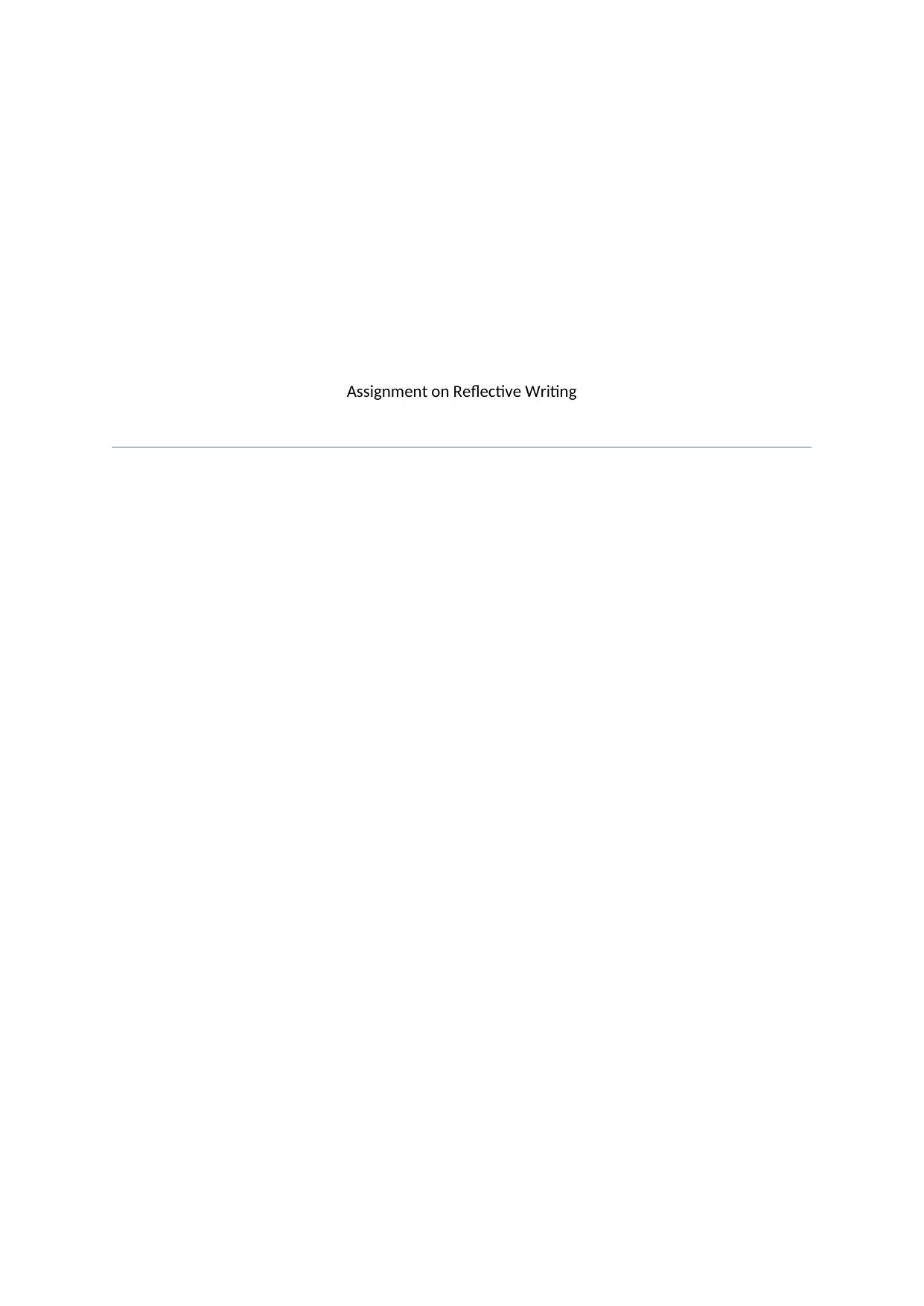
Assignment on Reflective Writing
Paraphrase This Document
Need a fresh take? Get an instant paraphrase of this document with our AI Paraphraser
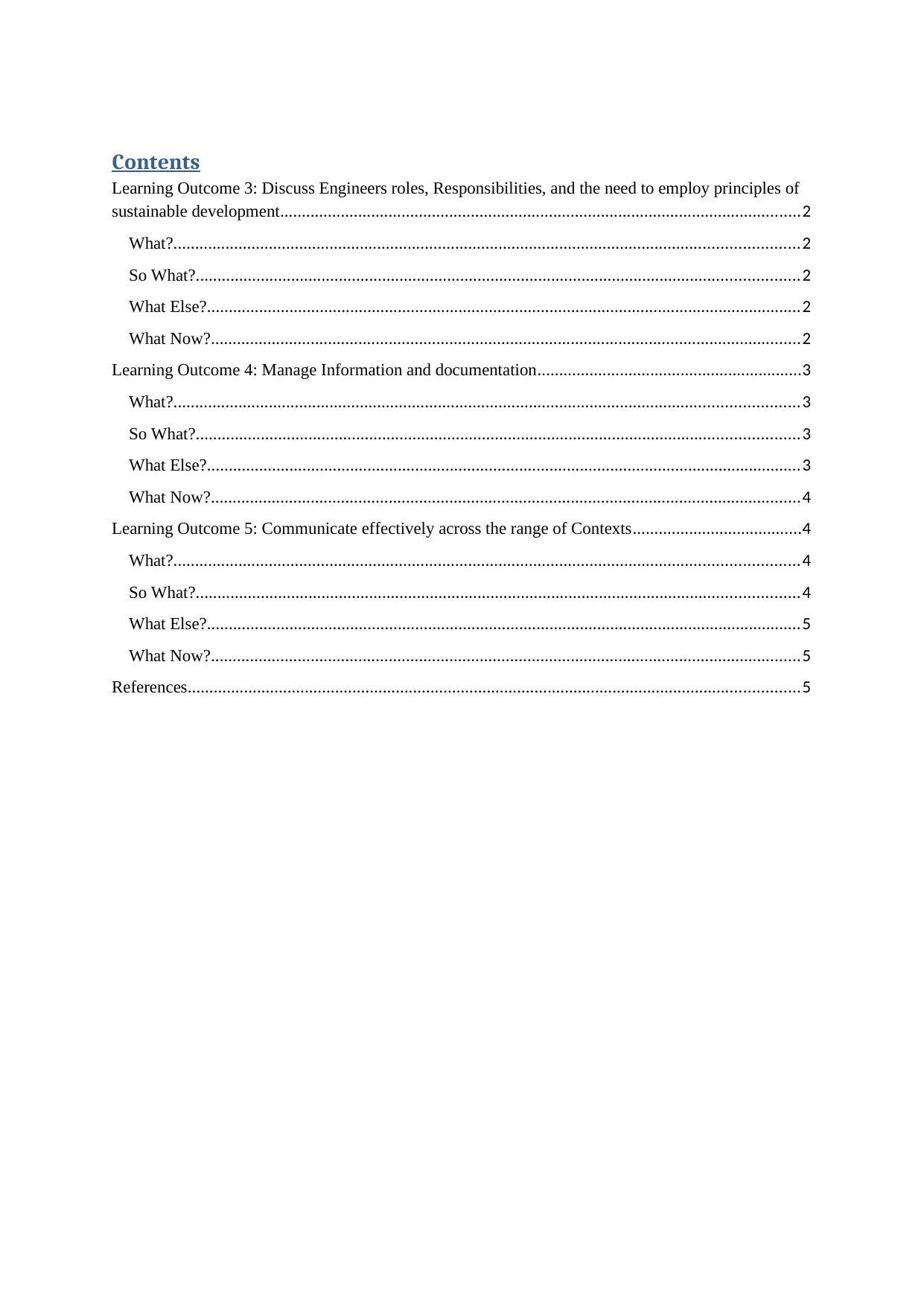
Contents
Learning Outcome 3: Discuss Engineers roles, Responsibilities, and the need to employ principles of
sustainable development........................................................................................................................2
What?................................................................................................................................................2
So What?...........................................................................................................................................2
What Else?.........................................................................................................................................2
What Now?........................................................................................................................................2
Learning Outcome 4: Manage Information and documentation.............................................................3
What?................................................................................................................................................3
So What?...........................................................................................................................................3
What Else?.........................................................................................................................................3
What Now?........................................................................................................................................4
Learning Outcome 5: Communicate effectively across the range of Contexts.......................................4
What?................................................................................................................................................4
So What?...........................................................................................................................................4
What Else?.........................................................................................................................................5
What Now?........................................................................................................................................5
References.............................................................................................................................................5
Learning Outcome 3: Discuss Engineers roles, Responsibilities, and the need to employ principles of
sustainable development........................................................................................................................2
What?................................................................................................................................................2
So What?...........................................................................................................................................2
What Else?.........................................................................................................................................2
What Now?........................................................................................................................................2
Learning Outcome 4: Manage Information and documentation.............................................................3
What?................................................................................................................................................3
So What?...........................................................................................................................................3
What Else?.........................................................................................................................................3
What Now?........................................................................................................................................4
Learning Outcome 5: Communicate effectively across the range of Contexts.......................................4
What?................................................................................................................................................4
So What?...........................................................................................................................................4
What Else?.........................................................................................................................................5
What Now?........................................................................................................................................5
References.............................................................................................................................................5
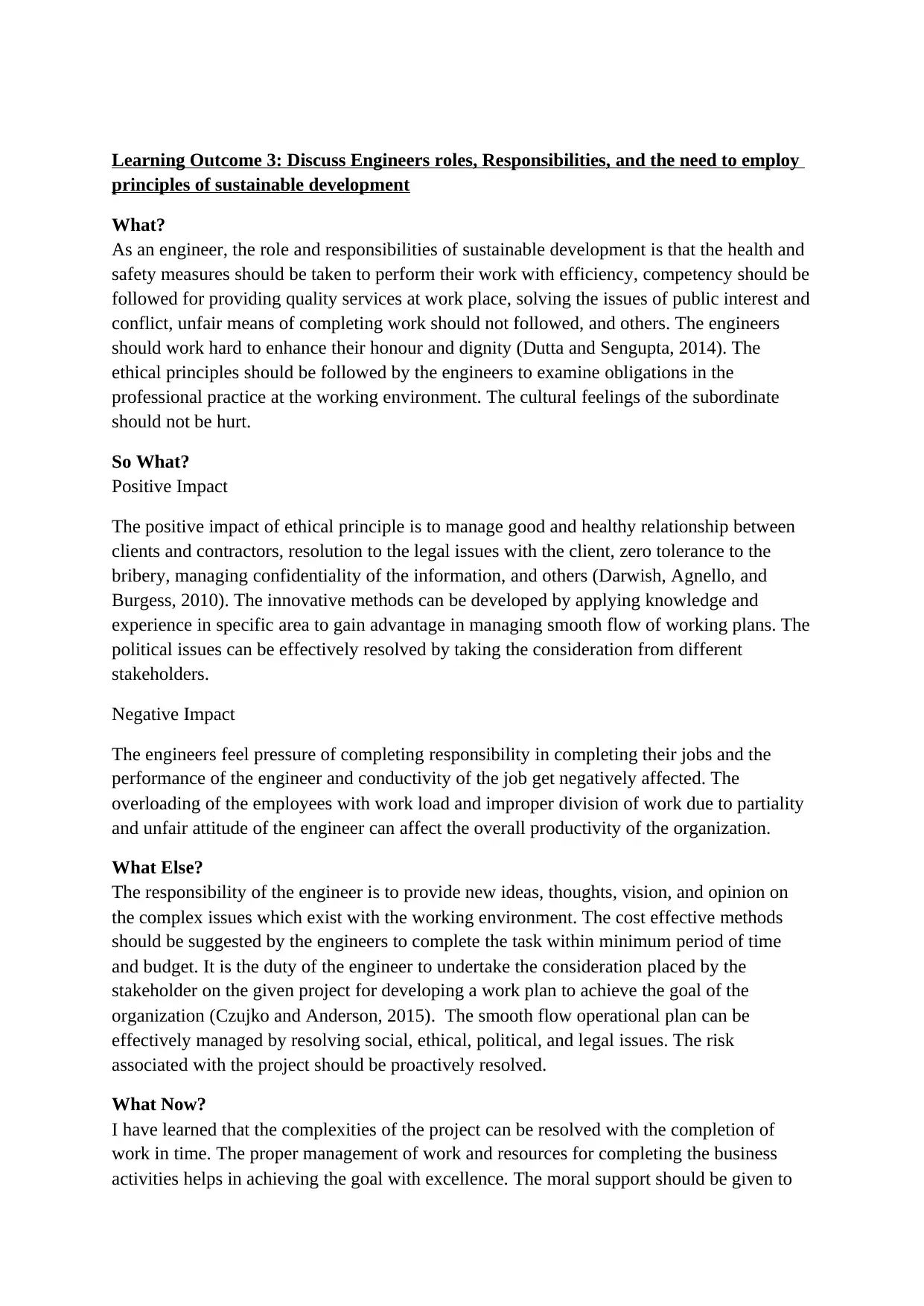
Learning Outcome 3: Discuss Engineers roles, Responsibilities, and the need to employ
principles of sustainable development
What?
As an engineer, the role and responsibilities of sustainable development is that the health and
safety measures should be taken to perform their work with efficiency, competency should be
followed for providing quality services at work place, solving the issues of public interest and
conflict, unfair means of completing work should not followed, and others. The engineers
should work hard to enhance their honour and dignity (Dutta and Sengupta, 2014). The
ethical principles should be followed by the engineers to examine obligations in the
professional practice at the working environment. The cultural feelings of the subordinate
should not be hurt.
So What?
Positive Impact
The positive impact of ethical principle is to manage good and healthy relationship between
clients and contractors, resolution to the legal issues with the client, zero tolerance to the
bribery, managing confidentiality of the information, and others (Darwish, Agnello, and
Burgess, 2010). The innovative methods can be developed by applying knowledge and
experience in specific area to gain advantage in managing smooth flow of working plans. The
political issues can be effectively resolved by taking the consideration from different
stakeholders.
Negative Impact
The engineers feel pressure of completing responsibility in completing their jobs and the
performance of the engineer and conductivity of the job get negatively affected. The
overloading of the employees with work load and improper division of work due to partiality
and unfair attitude of the engineer can affect the overall productivity of the organization.
What Else?
The responsibility of the engineer is to provide new ideas, thoughts, vision, and opinion on
the complex issues which exist with the working environment. The cost effective methods
should be suggested by the engineers to complete the task within minimum period of time
and budget. It is the duty of the engineer to undertake the consideration placed by the
stakeholder on the given project for developing a work plan to achieve the goal of the
organization (Czujko and Anderson, 2015). The smooth flow operational plan can be
effectively managed by resolving social, ethical, political, and legal issues. The risk
associated with the project should be proactively resolved.
What Now?
I have learned that the complexities of the project can be resolved with the completion of
work in time. The proper management of work and resources for completing the business
activities helps in achieving the goal with excellence. The moral support should be given to
principles of sustainable development
What?
As an engineer, the role and responsibilities of sustainable development is that the health and
safety measures should be taken to perform their work with efficiency, competency should be
followed for providing quality services at work place, solving the issues of public interest and
conflict, unfair means of completing work should not followed, and others. The engineers
should work hard to enhance their honour and dignity (Dutta and Sengupta, 2014). The
ethical principles should be followed by the engineers to examine obligations in the
professional practice at the working environment. The cultural feelings of the subordinate
should not be hurt.
So What?
Positive Impact
The positive impact of ethical principle is to manage good and healthy relationship between
clients and contractors, resolution to the legal issues with the client, zero tolerance to the
bribery, managing confidentiality of the information, and others (Darwish, Agnello, and
Burgess, 2010). The innovative methods can be developed by applying knowledge and
experience in specific area to gain advantage in managing smooth flow of working plans. The
political issues can be effectively resolved by taking the consideration from different
stakeholders.
Negative Impact
The engineers feel pressure of completing responsibility in completing their jobs and the
performance of the engineer and conductivity of the job get negatively affected. The
overloading of the employees with work load and improper division of work due to partiality
and unfair attitude of the engineer can affect the overall productivity of the organization.
What Else?
The responsibility of the engineer is to provide new ideas, thoughts, vision, and opinion on
the complex issues which exist with the working environment. The cost effective methods
should be suggested by the engineers to complete the task within minimum period of time
and budget. It is the duty of the engineer to undertake the consideration placed by the
stakeholder on the given project for developing a work plan to achieve the goal of the
organization (Czujko and Anderson, 2015). The smooth flow operational plan can be
effectively managed by resolving social, ethical, political, and legal issues. The risk
associated with the project should be proactively resolved.
What Now?
I have learned that the complexities of the project can be resolved with the completion of
work in time. The proper management of work and resources for completing the business
activities helps in achieving the goal with excellence. The moral support should be given to
⊘ This is a preview!⊘
Do you want full access?
Subscribe today to unlock all pages.

Trusted by 1+ million students worldwide
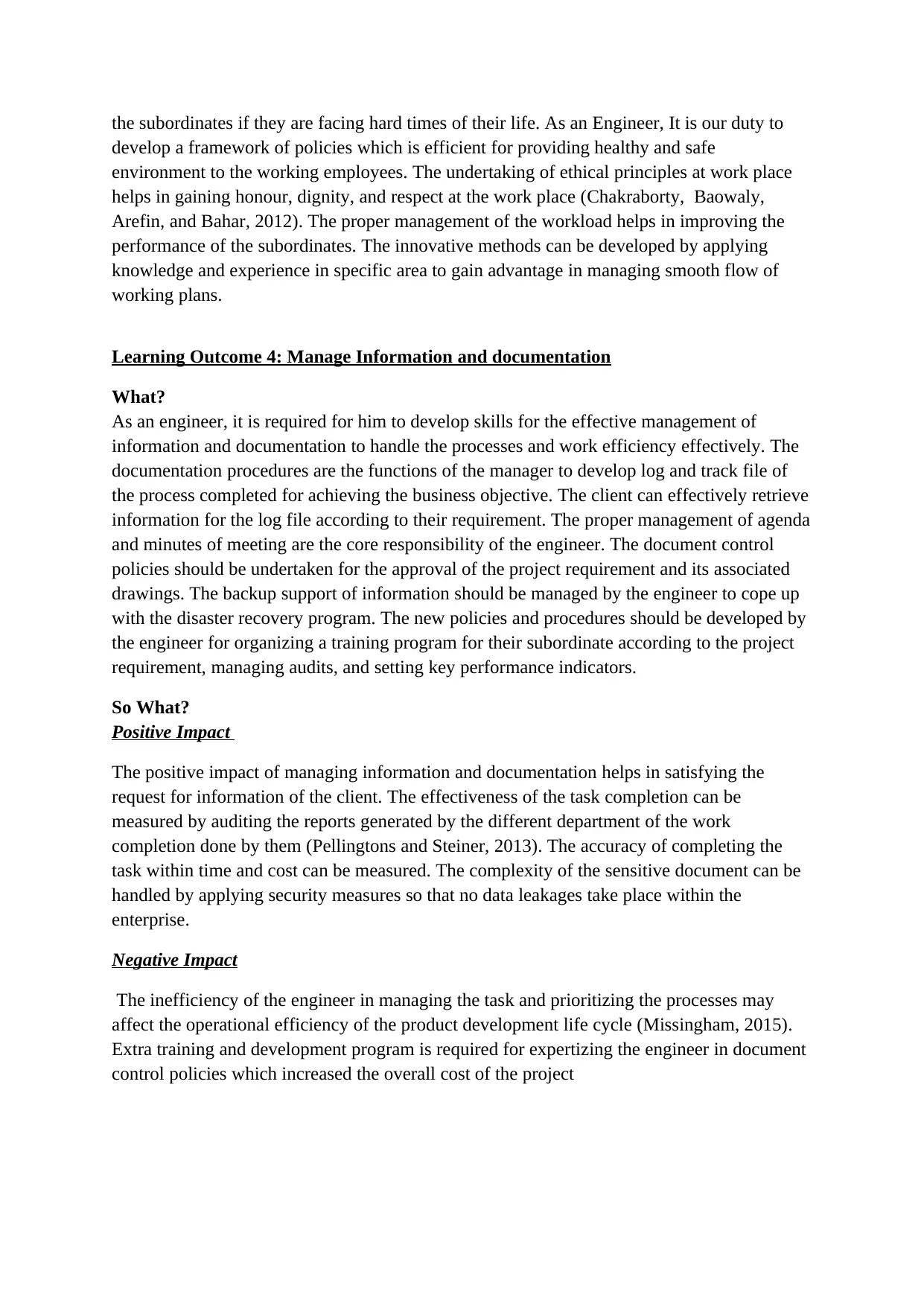
the subordinates if they are facing hard times of their life. As an Engineer, It is our duty to
develop a framework of policies which is efficient for providing healthy and safe
environment to the working employees. The undertaking of ethical principles at work place
helps in gaining honour, dignity, and respect at the work place (Chakraborty, Baowaly,
Arefin, and Bahar, 2012). The proper management of the workload helps in improving the
performance of the subordinates. The innovative methods can be developed by applying
knowledge and experience in specific area to gain advantage in managing smooth flow of
working plans.
Learning Outcome 4: Manage Information and documentation
What?
As an engineer, it is required for him to develop skills for the effective management of
information and documentation to handle the processes and work efficiency effectively. The
documentation procedures are the functions of the manager to develop log and track file of
the process completed for achieving the business objective. The client can effectively retrieve
information for the log file according to their requirement. The proper management of agenda
and minutes of meeting are the core responsibility of the engineer. The document control
policies should be undertaken for the approval of the project requirement and its associated
drawings. The backup support of information should be managed by the engineer to cope up
with the disaster recovery program. The new policies and procedures should be developed by
the engineer for organizing a training program for their subordinate according to the project
requirement, managing audits, and setting key performance indicators.
So What?
Positive Impact
The positive impact of managing information and documentation helps in satisfying the
request for information of the client. The effectiveness of the task completion can be
measured by auditing the reports generated by the different department of the work
completion done by them (Pellingtons and Steiner, 2013). The accuracy of completing the
task within time and cost can be measured. The complexity of the sensitive document can be
handled by applying security measures so that no data leakages take place within the
enterprise.
Negative Impact
The inefficiency of the engineer in managing the task and prioritizing the processes may
affect the operational efficiency of the product development life cycle (Missingham, 2015).
Extra training and development program is required for expertizing the engineer in document
control policies which increased the overall cost of the project
develop a framework of policies which is efficient for providing healthy and safe
environment to the working employees. The undertaking of ethical principles at work place
helps in gaining honour, dignity, and respect at the work place (Chakraborty, Baowaly,
Arefin, and Bahar, 2012). The proper management of the workload helps in improving the
performance of the subordinates. The innovative methods can be developed by applying
knowledge and experience in specific area to gain advantage in managing smooth flow of
working plans.
Learning Outcome 4: Manage Information and documentation
What?
As an engineer, it is required for him to develop skills for the effective management of
information and documentation to handle the processes and work efficiency effectively. The
documentation procedures are the functions of the manager to develop log and track file of
the process completed for achieving the business objective. The client can effectively retrieve
information for the log file according to their requirement. The proper management of agenda
and minutes of meeting are the core responsibility of the engineer. The document control
policies should be undertaken for the approval of the project requirement and its associated
drawings. The backup support of information should be managed by the engineer to cope up
with the disaster recovery program. The new policies and procedures should be developed by
the engineer for organizing a training program for their subordinate according to the project
requirement, managing audits, and setting key performance indicators.
So What?
Positive Impact
The positive impact of managing information and documentation helps in satisfying the
request for information of the client. The effectiveness of the task completion can be
measured by auditing the reports generated by the different department of the work
completion done by them (Pellingtons and Steiner, 2013). The accuracy of completing the
task within time and cost can be measured. The complexity of the sensitive document can be
handled by applying security measures so that no data leakages take place within the
enterprise.
Negative Impact
The inefficiency of the engineer in managing the task and prioritizing the processes may
affect the operational efficiency of the product development life cycle (Missingham, 2015).
Extra training and development program is required for expertizing the engineer in document
control policies which increased the overall cost of the project
Paraphrase This Document
Need a fresh take? Get an instant paraphrase of this document with our AI Paraphraser
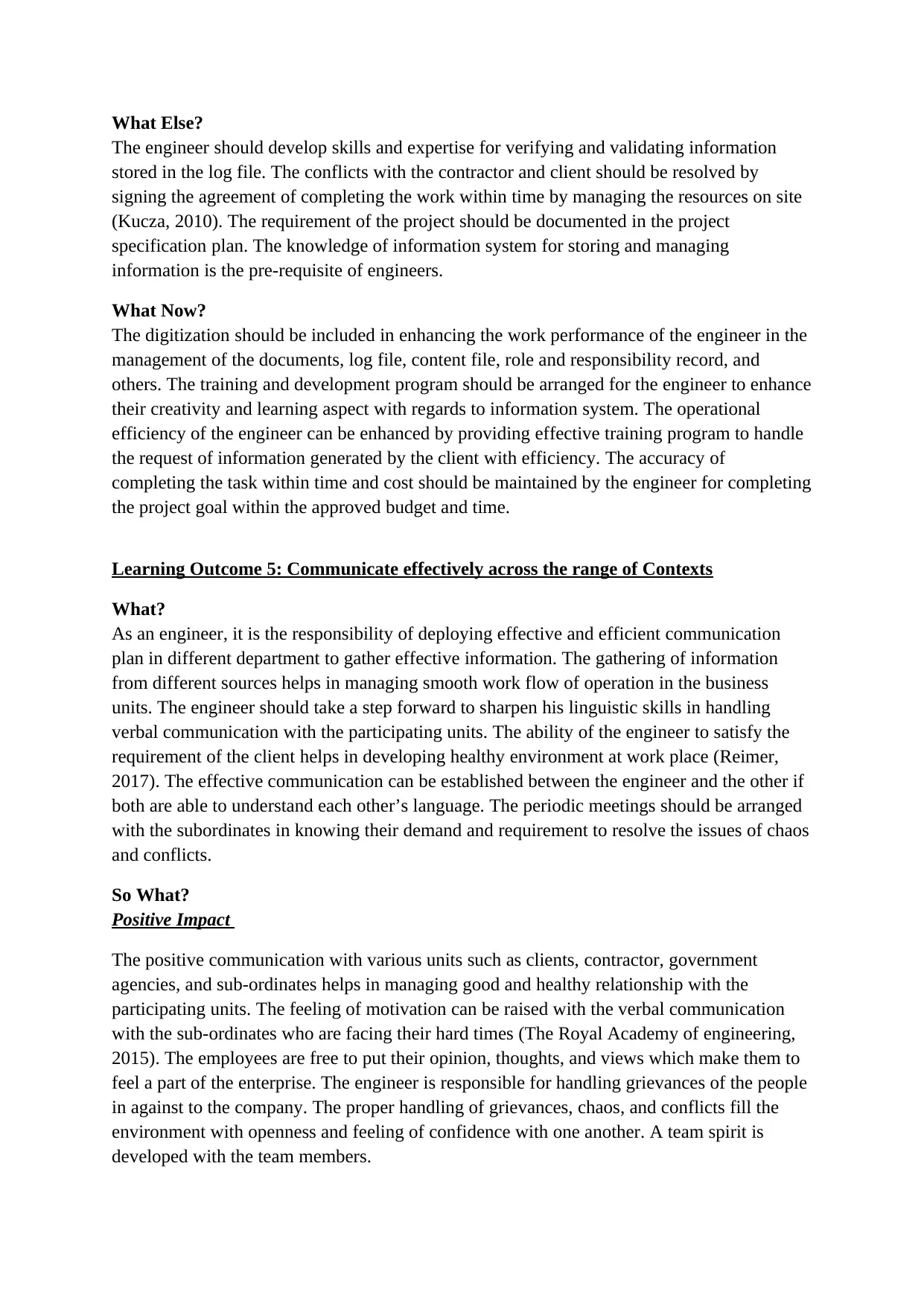
What Else?
The engineer should develop skills and expertise for verifying and validating information
stored in the log file. The conflicts with the contractor and client should be resolved by
signing the agreement of completing the work within time by managing the resources on site
(Kucza, 2010). The requirement of the project should be documented in the project
specification plan. The knowledge of information system for storing and managing
information is the pre-requisite of engineers.
What Now?
The digitization should be included in enhancing the work performance of the engineer in the
management of the documents, log file, content file, role and responsibility record, and
others. The training and development program should be arranged for the engineer to enhance
their creativity and learning aspect with regards to information system. The operational
efficiency of the engineer can be enhanced by providing effective training program to handle
the request of information generated by the client with efficiency. The accuracy of
completing the task within time and cost should be maintained by the engineer for completing
the project goal within the approved budget and time.
Learning Outcome 5: Communicate effectively across the range of Contexts
What?
As an engineer, it is the responsibility of deploying effective and efficient communication
plan in different department to gather effective information. The gathering of information
from different sources helps in managing smooth work flow of operation in the business
units. The engineer should take a step forward to sharpen his linguistic skills in handling
verbal communication with the participating units. The ability of the engineer to satisfy the
requirement of the client helps in developing healthy environment at work place (Reimer,
2017). The effective communication can be established between the engineer and the other if
both are able to understand each other’s language. The periodic meetings should be arranged
with the subordinates in knowing their demand and requirement to resolve the issues of chaos
and conflicts.
So What?
Positive Impact
The positive communication with various units such as clients, contractor, government
agencies, and sub-ordinates helps in managing good and healthy relationship with the
participating units. The feeling of motivation can be raised with the verbal communication
with the sub-ordinates who are facing their hard times (The Royal Academy of engineering,
2015). The employees are free to put their opinion, thoughts, and views which make them to
feel a part of the enterprise. The engineer is responsible for handling grievances of the people
in against to the company. The proper handling of grievances, chaos, and conflicts fill the
environment with openness and feeling of confidence with one another. A team spirit is
developed with the team members.
The engineer should develop skills and expertise for verifying and validating information
stored in the log file. The conflicts with the contractor and client should be resolved by
signing the agreement of completing the work within time by managing the resources on site
(Kucza, 2010). The requirement of the project should be documented in the project
specification plan. The knowledge of information system for storing and managing
information is the pre-requisite of engineers.
What Now?
The digitization should be included in enhancing the work performance of the engineer in the
management of the documents, log file, content file, role and responsibility record, and
others. The training and development program should be arranged for the engineer to enhance
their creativity and learning aspect with regards to information system. The operational
efficiency of the engineer can be enhanced by providing effective training program to handle
the request of information generated by the client with efficiency. The accuracy of
completing the task within time and cost should be maintained by the engineer for completing
the project goal within the approved budget and time.
Learning Outcome 5: Communicate effectively across the range of Contexts
What?
As an engineer, it is the responsibility of deploying effective and efficient communication
plan in different department to gather effective information. The gathering of information
from different sources helps in managing smooth work flow of operation in the business
units. The engineer should take a step forward to sharpen his linguistic skills in handling
verbal communication with the participating units. The ability of the engineer to satisfy the
requirement of the client helps in developing healthy environment at work place (Reimer,
2017). The effective communication can be established between the engineer and the other if
both are able to understand each other’s language. The periodic meetings should be arranged
with the subordinates in knowing their demand and requirement to resolve the issues of chaos
and conflicts.
So What?
Positive Impact
The positive communication with various units such as clients, contractor, government
agencies, and sub-ordinates helps in managing good and healthy relationship with the
participating units. The feeling of motivation can be raised with the verbal communication
with the sub-ordinates who are facing their hard times (The Royal Academy of engineering,
2015). The employees are free to put their opinion, thoughts, and views which make them to
feel a part of the enterprise. The engineer is responsible for handling grievances of the people
in against to the company. The proper handling of grievances, chaos, and conflicts fill the
environment with openness and feeling of confidence with one another. A team spirit is
developed with the team members.
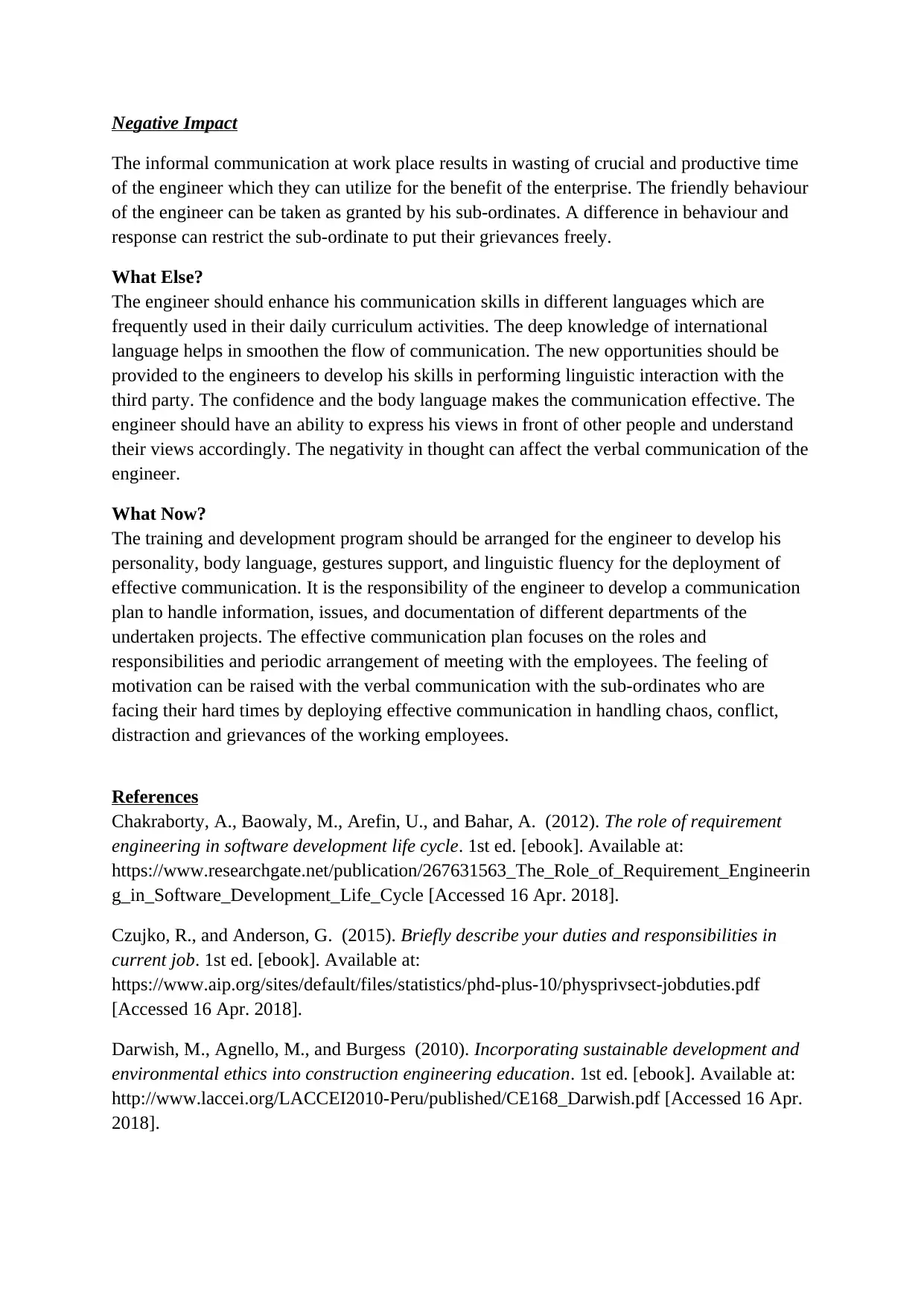
Negative Impact
The informal communication at work place results in wasting of crucial and productive time
of the engineer which they can utilize for the benefit of the enterprise. The friendly behaviour
of the engineer can be taken as granted by his sub-ordinates. A difference in behaviour and
response can restrict the sub-ordinate to put their grievances freely.
What Else?
The engineer should enhance his communication skills in different languages which are
frequently used in their daily curriculum activities. The deep knowledge of international
language helps in smoothen the flow of communication. The new opportunities should be
provided to the engineers to develop his skills in performing linguistic interaction with the
third party. The confidence and the body language makes the communication effective. The
engineer should have an ability to express his views in front of other people and understand
their views accordingly. The negativity in thought can affect the verbal communication of the
engineer.
What Now?
The training and development program should be arranged for the engineer to develop his
personality, body language, gestures support, and linguistic fluency for the deployment of
effective communication. It is the responsibility of the engineer to develop a communication
plan to handle information, issues, and documentation of different departments of the
undertaken projects. The effective communication plan focuses on the roles and
responsibilities and periodic arrangement of meeting with the employees. The feeling of
motivation can be raised with the verbal communication with the sub-ordinates who are
facing their hard times by deploying effective communication in handling chaos, conflict,
distraction and grievances of the working employees.
References
Chakraborty, A., Baowaly, M., Arefin, U., and Bahar, A. (2012). The role of requirement
engineering in software development life cycle. 1st ed. [ebook]. Available at:
https://www.researchgate.net/publication/267631563_The_Role_of_Requirement_Engineerin
g_in_Software_Development_Life_Cycle [Accessed 16 Apr. 2018].
Czujko, R., and Anderson, G. (2015). Briefly describe your duties and responsibilities in
current job. 1st ed. [ebook]. Available at:
https://www.aip.org/sites/default/files/statistics/phd-plus-10/physprivsect-jobduties.pdf
[Accessed 16 Apr. 2018].
Darwish, M., Agnello, M., and Burgess (2010). Incorporating sustainable development and
environmental ethics into construction engineering education. 1st ed. [ebook]. Available at:
http://www.laccei.org/LACCEI2010-Peru/published/CE168_Darwish.pdf [Accessed 16 Apr.
2018].
The informal communication at work place results in wasting of crucial and productive time
of the engineer which they can utilize for the benefit of the enterprise. The friendly behaviour
of the engineer can be taken as granted by his sub-ordinates. A difference in behaviour and
response can restrict the sub-ordinate to put their grievances freely.
What Else?
The engineer should enhance his communication skills in different languages which are
frequently used in their daily curriculum activities. The deep knowledge of international
language helps in smoothen the flow of communication. The new opportunities should be
provided to the engineers to develop his skills in performing linguistic interaction with the
third party. The confidence and the body language makes the communication effective. The
engineer should have an ability to express his views in front of other people and understand
their views accordingly. The negativity in thought can affect the verbal communication of the
engineer.
What Now?
The training and development program should be arranged for the engineer to develop his
personality, body language, gestures support, and linguistic fluency for the deployment of
effective communication. It is the responsibility of the engineer to develop a communication
plan to handle information, issues, and documentation of different departments of the
undertaken projects. The effective communication plan focuses on the roles and
responsibilities and periodic arrangement of meeting with the employees. The feeling of
motivation can be raised with the verbal communication with the sub-ordinates who are
facing their hard times by deploying effective communication in handling chaos, conflict,
distraction and grievances of the working employees.
References
Chakraborty, A., Baowaly, M., Arefin, U., and Bahar, A. (2012). The role of requirement
engineering in software development life cycle. 1st ed. [ebook]. Available at:
https://www.researchgate.net/publication/267631563_The_Role_of_Requirement_Engineerin
g_in_Software_Development_Life_Cycle [Accessed 16 Apr. 2018].
Czujko, R., and Anderson, G. (2015). Briefly describe your duties and responsibilities in
current job. 1st ed. [ebook]. Available at:
https://www.aip.org/sites/default/files/statistics/phd-plus-10/physprivsect-jobduties.pdf
[Accessed 16 Apr. 2018].
Darwish, M., Agnello, M., and Burgess (2010). Incorporating sustainable development and
environmental ethics into construction engineering education. 1st ed. [ebook]. Available at:
http://www.laccei.org/LACCEI2010-Peru/published/CE168_Darwish.pdf [Accessed 16 Apr.
2018].
⊘ This is a preview!⊘
Do you want full access?
Subscribe today to unlock all pages.

Trusted by 1+ million students worldwide
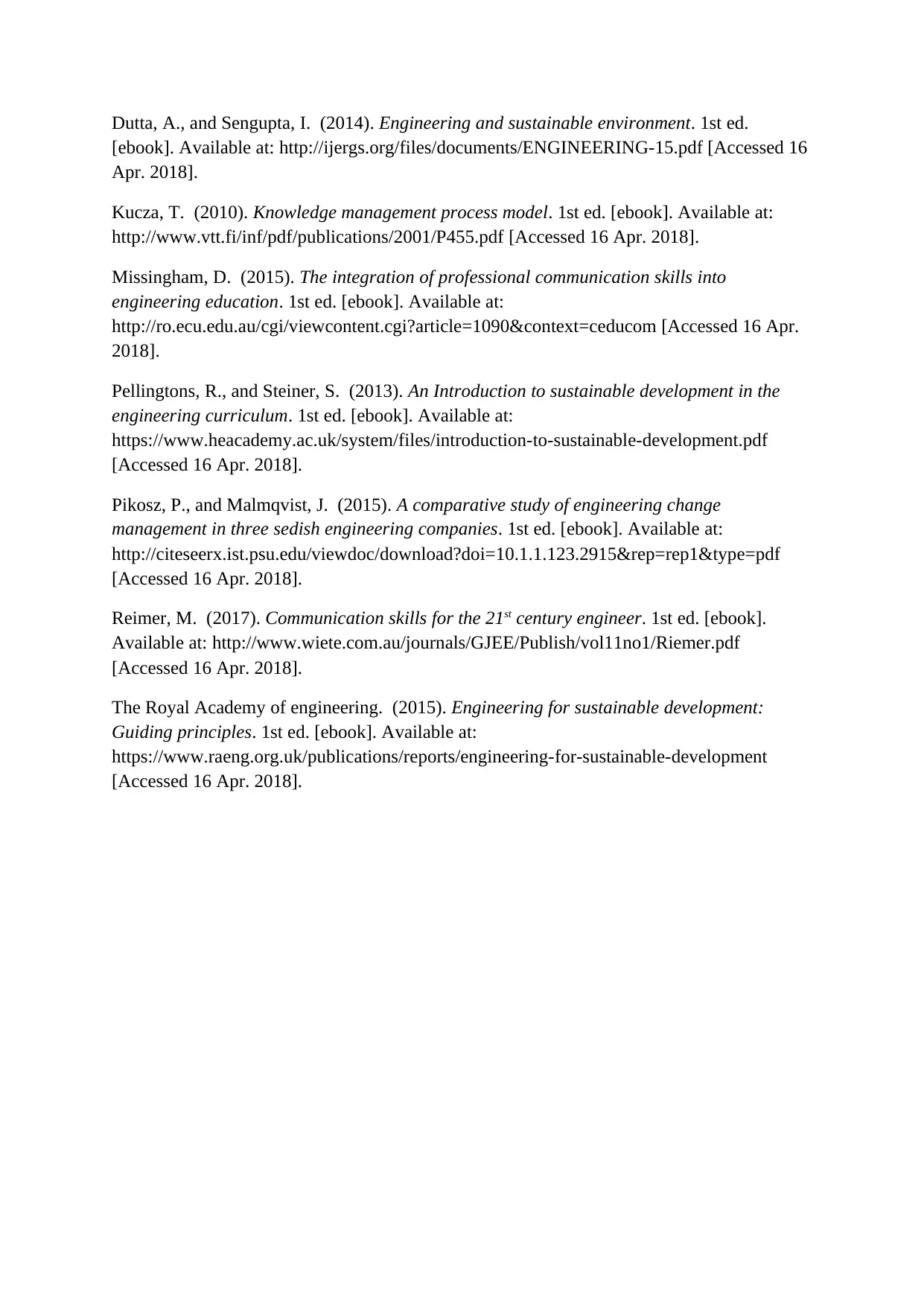
Dutta, A., and Sengupta, I. (2014). Engineering and sustainable environment. 1st ed.
[ebook]. Available at: http://ijergs.org/files/documents/ENGINEERING-15.pdf [Accessed 16
Apr. 2018].
Kucza, T. (2010). Knowledge management process model. 1st ed. [ebook]. Available at:
http://www.vtt.fi/inf/pdf/publications/2001/P455.pdf [Accessed 16 Apr. 2018].
Missingham, D. (2015). The integration of professional communication skills into
engineering education. 1st ed. [ebook]. Available at:
http://ro.ecu.edu.au/cgi/viewcontent.cgi?article=1090&context=ceducom [Accessed 16 Apr.
2018].
Pellingtons, R., and Steiner, S. (2013). An Introduction to sustainable development in the
engineering curriculum. 1st ed. [ebook]. Available at:
https://www.heacademy.ac.uk/system/files/introduction-to-sustainable-development.pdf
[Accessed 16 Apr. 2018].
Pikosz, P., and Malmqvist, J. (2015). A comparative study of engineering change
management in three sedish engineering companies. 1st ed. [ebook]. Available at:
http://citeseerx.ist.psu.edu/viewdoc/download?doi=10.1.1.123.2915&rep=rep1&type=pdf
[Accessed 16 Apr. 2018].
Reimer, M. (2017). Communication skills for the 21st century engineer. 1st ed. [ebook].
Available at: http://www.wiete.com.au/journals/GJEE/Publish/vol11no1/Riemer.pdf
[Accessed 16 Apr. 2018].
The Royal Academy of engineering. (2015). Engineering for sustainable development:
Guiding principles. 1st ed. [ebook]. Available at:
https://www.raeng.org.uk/publications/reports/engineering-for-sustainable-development
[Accessed 16 Apr. 2018].
[ebook]. Available at: http://ijergs.org/files/documents/ENGINEERING-15.pdf [Accessed 16
Apr. 2018].
Kucza, T. (2010). Knowledge management process model. 1st ed. [ebook]. Available at:
http://www.vtt.fi/inf/pdf/publications/2001/P455.pdf [Accessed 16 Apr. 2018].
Missingham, D. (2015). The integration of professional communication skills into
engineering education. 1st ed. [ebook]. Available at:
http://ro.ecu.edu.au/cgi/viewcontent.cgi?article=1090&context=ceducom [Accessed 16 Apr.
2018].
Pellingtons, R., and Steiner, S. (2013). An Introduction to sustainable development in the
engineering curriculum. 1st ed. [ebook]. Available at:
https://www.heacademy.ac.uk/system/files/introduction-to-sustainable-development.pdf
[Accessed 16 Apr. 2018].
Pikosz, P., and Malmqvist, J. (2015). A comparative study of engineering change
management in three sedish engineering companies. 1st ed. [ebook]. Available at:
http://citeseerx.ist.psu.edu/viewdoc/download?doi=10.1.1.123.2915&rep=rep1&type=pdf
[Accessed 16 Apr. 2018].
Reimer, M. (2017). Communication skills for the 21st century engineer. 1st ed. [ebook].
Available at: http://www.wiete.com.au/journals/GJEE/Publish/vol11no1/Riemer.pdf
[Accessed 16 Apr. 2018].
The Royal Academy of engineering. (2015). Engineering for sustainable development:
Guiding principles. 1st ed. [ebook]. Available at:
https://www.raeng.org.uk/publications/reports/engineering-for-sustainable-development
[Accessed 16 Apr. 2018].
1 out of 7
Related Documents
Your All-in-One AI-Powered Toolkit for Academic Success.
+13062052269
info@desklib.com
Available 24*7 on WhatsApp / Email
![[object Object]](/_next/static/media/star-bottom.7253800d.svg)
Unlock your academic potential
Copyright © 2020–2025 A2Z Services. All Rights Reserved. Developed and managed by ZUCOL.



